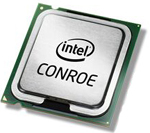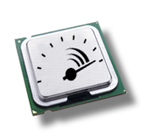Article: Intel® Core™ 2 Overclock Helper for Beginner
(N=Newbie, E=Hardware Enthusiast, O=Overclocker, B=Budget)
Disclaimer:
^The download is an Excel file, while I have tested and scanned it free of virus and spam, you are still given a fair warning to whether to download it or not. Proceed at your own risk.
 Download it here Beta 0.99.
Download it here Beta 0.99.
I. Introduction

The Intel® Core™ 2 series of processors has hit the market and it's been giving a lot of PC users excitement and fun. For those who stayed the course using Chipzilla products and true enthusiasts will know that mobile processor, Banias/Dothan, has really shown great performance clock for clock against any processors of its time, and has great power to performance ratio.
Like a plague, almost all if not all, tech forums, tech web sites, magazines, and even in every enthusiasts casual chats, has been talking about how great the processor is, and in fact, this is the most anticipated product launch of the century. Chipzilla is even touting it as the "World's Best".

And for those who have played with NetBurst, the desktop counterpart of Dothan/Banias in its time, knows that processors based on this uA are great clockers, and I mean "uber" high clock. What Banias/Dothan lacks (clock frequency), the NetBurst uA has it and what NetBurst lacks (IPC/watt), the Banias/Dothan uA has it. Add the two together and you have the new uA called NGMA aka Next Generation Micro Architecture aka and what it is know today, Intel® Core™ 2 E6000 and X6000 series of processors and playing with these babies will just be a walk in the park, a daily routine if you may. This makes perfect sense, combine the strong points and eliminate the weak points, and you got an outstanding product.
However, for those who are new comer and has just been lured by Chipzilla's unrelenting push to ther market, or maybe, an old timer who lost track of current technology, or maybe, an enthusiast who once waive a different flag (a green one), may see this new beast a bit confusing. So to help out technical newbies (not complete newbies), I have made this simple Excel file that will just compute the clock frequency base on multiplier and FSB, and even shows memory frequency. If you are a complete noobie and doesn't even know what FSB is, I suggest reading your hardware manual and learn the parts of your motherboard. Pay attention to where the Northbridge is (and what it is), Southbridge (and what it is) and the ever helpful CMOS reset jumper. So let's get on with it...
II. The Overclock Helper

So, what is this Overclock Helper anyway? As mentioned earlier, this will help assist in learning more about the processor, memory, and how they are related. It has three sheets (How-to and Readme 1st, Template, Processor Info), but focus will be on the second sheet (Template) while the other two are just informational. The first and last worksheets are self expanatory and the "Template" is pretty much easy to use so I'll just briefly give a short rundown on how to use it.
- First, you must at least know what your processor is or have an idea of what you like to buy. You can then look up more details on the "Processor Info" worksheet. Don't forget to check the password unprotect on the "How-to and Readme 1st" worksheet. It may change from time to time.
- After you have the info, you can then use this info on the "Template" worksheet and enter the values in B3 and B4 for the default or stock value of the processor.
- Now, depending on your processor (ES, Extreme Edition) or motherboard and BIOS version, you may or may not be able to alter the clock multiplier in C3. If not, after editing B3 and B4, your next stop will be C4.
- From here on, you can just see the results on different columns, or you can also read some "wordy" info on lines 13-17.
- Done!
It's as simple as that, go ahead and give it a try here.